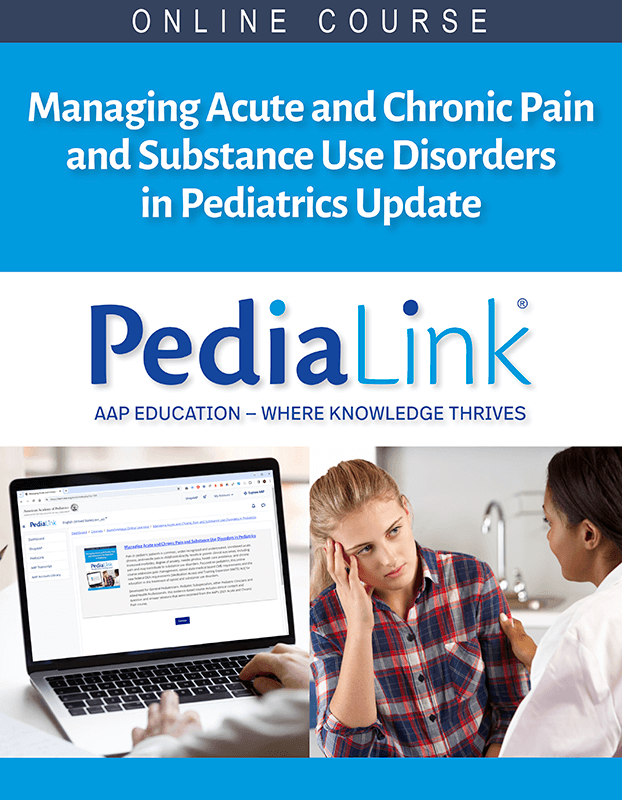Description
This course meets the government-mandated requirement for all DEA-registered practitioners to complete eight hours of training on the treatment and management of patients with opioid or other substance use disorders prior to applying for or renewing their license.
Pain in pediatric patients is common, under-recognized, and undertreated. Unrelieved acute, chronic, and needle pain in childhood directly results in poorer clinical outcomes, including increased morbidity, degree of anxiety, needle-phobia, health care avoidance, and chronic pain, which may contribute to substance use disorders.
Focused on pediatrics, this online course addresses pain management and opioid state medical board CME requirements. It also meets the new DEA requirements, found in the Medication Access and Training Expansion (MATE) Act, to complete eight hours of training on the treatment and management of patients with opioid or other substance use disorders prior to applying for or renewing their license.
Developed for general pediatricians, pediatric subspecialists, other pediatric clinicians, and allied health professionals, this evidence-based course includes clinical content and Q&A sessions from the 2023 AAP course, Treatment and Prevention of Acute and Chronic Pain in Children.
By participating in this CME activity, you will be able to:
- Diagnose, manage, and treat children from infancy to adolescence for acute and chronic pain.
- Identify and implement strategies to address substance use disorders and safely prescribe analgesics in pediatric practice.
- Identify the influence of bias and adverse childhood events on pain treatment.
|
Managing Acute and Chronic Pain and Substance Use Disorders in Pediatrics Update
|
|
Recording
|
Faculty
|
|
How to use Hypnotic Language and Hypnosis in your Pediatric Practice to treat pain and anxiety
|
David K. Becker, MD, LMFT, FAAP
|
|
Adverse Childhood Experiences and Pediatric Pain
|
Cristina Benki, PhD
|
|
Primary Pain Disorders: Headaches, Tummy Pain, and Sore Muscles/Joints: Red Flags for Further Workup, Evidence of "Preventatives" and other Pharmacology, Effective Treatment Strategies
|
William E. Bernal, MD, MPH
|
|
Simple Analgesia? Acetaminophen, NSAIDs and Cox-2 Inhibitors
|
David A. Burns, MD
|
|
Opioid Selection and Safe Prescribing in Pediatrics: Discussing Possible Risks With Every Family
|
Deepa Camenga, MD, MHS, FAAP
|
|
What is Pain in Children: I Know it When I see it?
|
Stefan J. Friedrichsdorf, MD, FAAP
|
|
Treatment of Opioid Use Disorder
|
Lucien Gonzalez, MD, MS, FAAP
|
|
Opioids in Pediatrics: Indications and Contra-indications
|
Stephen R. Hays, MD, FAAP
|
|
Sickle-Cell Pain: Acute and Chronic Pain Treatment and Prevention
|
Claudia R. Morris, MD, FAAP
|
|
Pain in a Child with Developmental Disability: What to do When your Pain Treatment Doesn't Seem to Work
|
Tim Oberlander, MD
|
|
Cannabis and Cannabinoids for Acute, Chronic and Neuropathic Pain Treatment: What is the Evidence Regarding Safety and Efficacy?
|
Andrew S. C. Rice, MD, FRCP, FRCA, FFPMRCA, FFPMCAI
|
|
Moving Along? Exercise and Physical Therapy in Pediatric Pain Treatment
|
Michael Sangster, BScPT, DPT
|
|
Chronic Pain = Real Pain and Not Just in Your Head! The Broken-Car-Alarm and Other Metaphors: How to Explain Chronic Pain to Parents and Patients (and avoid further testing)
|
Neil L. Schechter, MD, FAAP; Dr. Wilder
|
|
Opioid Rotation in Kids: Equianalgesic from Coke to Pepsi?
|
Scott A. Schwantes, MD, FAAHPM, FAAP
|
|
Substance Use Disorder in Pediatrics: Introduction to Screening and Treatment Options
|
Christine B. Sieberg, PhD, EdM, MA
|
|
Multimodal Analgesia: Better Pain Control with Fewer Side Effects
|
Karen I. Sun, MD
|
|
Implicit Bias and its Consequences on Pediatric Pain Management
|
Marsha Treadwell, PhD
|
|
The Elephant in the Room - Appropriate Analgesia in the Time of an Opioid Epidemic
|
Gary A. Walco, PhD, ABPP
|
Course Details
- Start Date: December 8, 2023
- Online Access Expires: July 31, 2026
- Credit Expires: July 31, 2026
- Course ID: 60985
Faculty
Faculty (Subject Matter Experts)
David K. Becker, MD, LMFT, FAAP
Cristina Benki, PhD
William E. Bernal, MD, MPH
David A. Burns, MD
Deepa Camenga, MD, MHS, FAAP
Stefan J. Friedrichsdorf, MD, FAAP
Lucien Gonzalez, MD, MS, FAAP
Stephen R. Hays, MD, FAAP
Claudia R. Morris, MD, FAAP
Tim F. Oberlander, MD
Andrew S.C. Rice, MD, FRCP, FRCA, FFPMRCA, FFPMCAI
Michael Sangster, BScPT, DPT
Neil L. Schechter, MD, FAAP
Scott A. Schwantes, MD, FAAHPM, FAAP
Christine B. Sieberg, PhD, EdM, MA
Karen I. Sun, MD
Marsha Treadwell, PhD
Gary A. Walco, PhD, ABPP
Planning Group
Stefan Friedrichsdorf, MD, FAAP - Chair
Lucien Gonzalez, MD, MS, FAAP
Hilary M. Haftel, MD, MHPE, FAAP
Robert Wilder, MD, PhD, FAAP

